J Research: In-depth insights into Web3 gaming industry trends in 2024
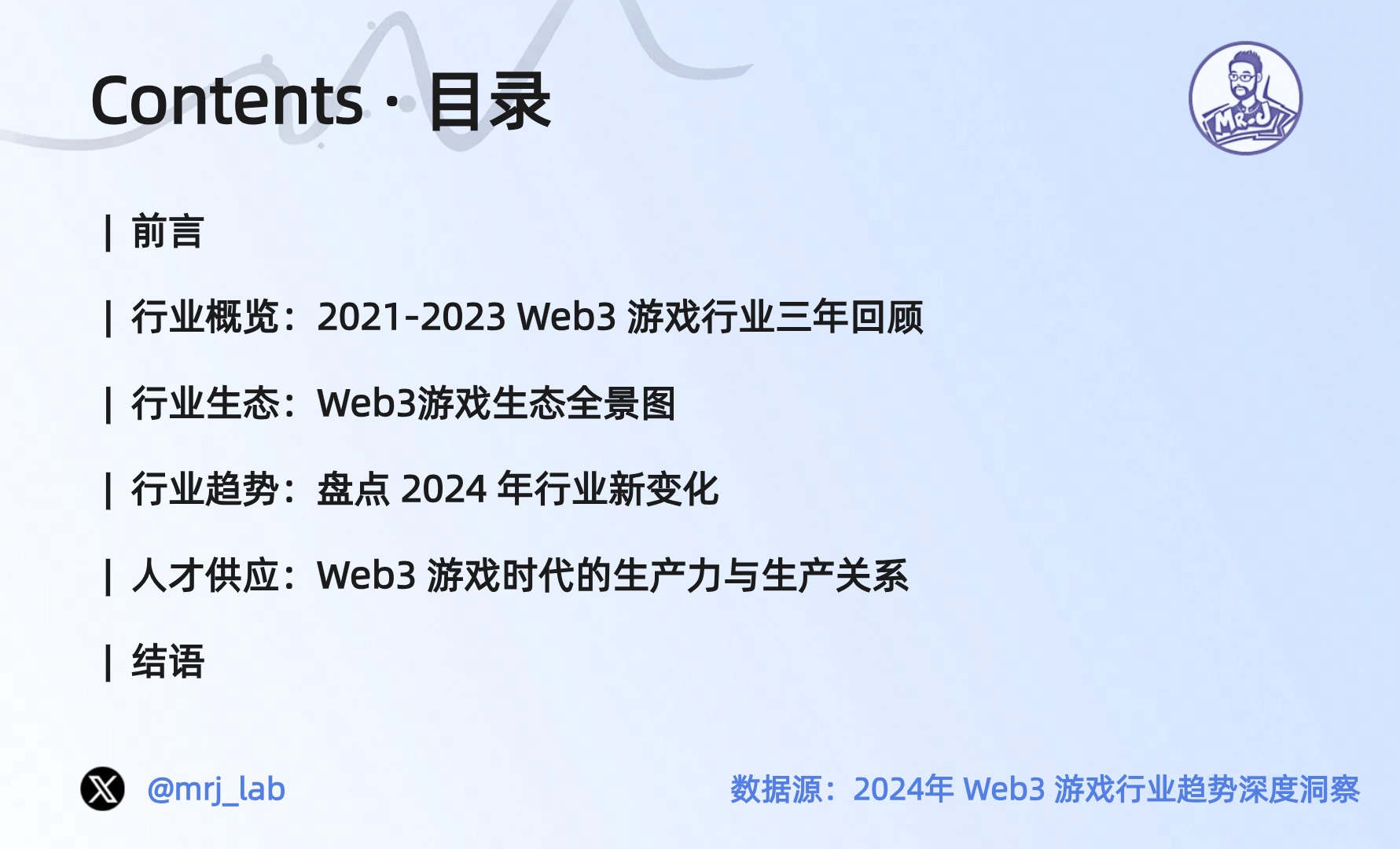
Games have always been seen as a key track to unlock the next traffic entrance for the Web3 industry.
At present, the crypto market is gradually recovering, but it is still in a state of volatility and uncertainty. At this time, we will focus on the game track, but after 2-3 years of development, we can find that Web3 games have already shown some new development characteristics. For example, the project has improved in the direction of improving gameplay and playability; based on several "explosive" cases in the early years, Web3 game types are constantly being innovated and expanding; the project is gradually evolving towards platformization and ecology, thereby enhancing risk resistance...
Based on this, J Lab spent nearly two months reviewing and collating 20+ research reports, collecting industry data from multiple dimensions, and analyzing the new features and talent trends of Web3 games in 2024 on the basis of combing through the panoramic view of the industry ecology. It aims to provide valuable reference for those who are concerned about the industry. If there are any inappropriate points, please criticize and correct us!
1. Industry Overview: 2021-2023 Web3 Gaming Industry Three-Year Review
2021-2023 is the first booming cycle of the Web3 gaming industry. The rapid growth of users, continuous innovation in business models, and massive influx of capital have jointly promoted the rapid development of the industry.
1. Market size: The “explosive” effect drives rapid growth in transaction volume, with users accounting for more than half of the industry
In 2021, Axie Infinity became one of the most profitable games on Ethereum at the time and became popular, attracting a large number of users to join the game. The number of blockchain game users increased from 80,000 in early April 2021 to 1.33 million in October, with an average monthly increase of more than 270%.
According to DappRadar's data report, the transaction volume of the blockchain game industry was relatively stable from 2021 to 2023, and exploded in the first quarter of 2024. In 2021, the number of unique active wallets (UAW) in Web3 games exceeded 1.4 million per day, accounting for 49% of the total usage of wallet addresses in the entire crypto industry, which even exceeded DeFi; in 2022, Web3 games attracted 1.15 million active wallets, with the same proportion; as the total usage of wallet addresses in the crypto industry increased, the proportion declined in 2023 under the premise that Web3 game UAW remained stable; and in the first quarter of 2024, the number of daily active wallets hit a record high, averaging more than 2 million per day, and the number of active wallets related to games accounted for 30% of the total number in the industry. Although the proportion has declined, the number has always fluctuated upward, which is consistent with the increase in the usage of wallet addresses in the entire crypto industry.
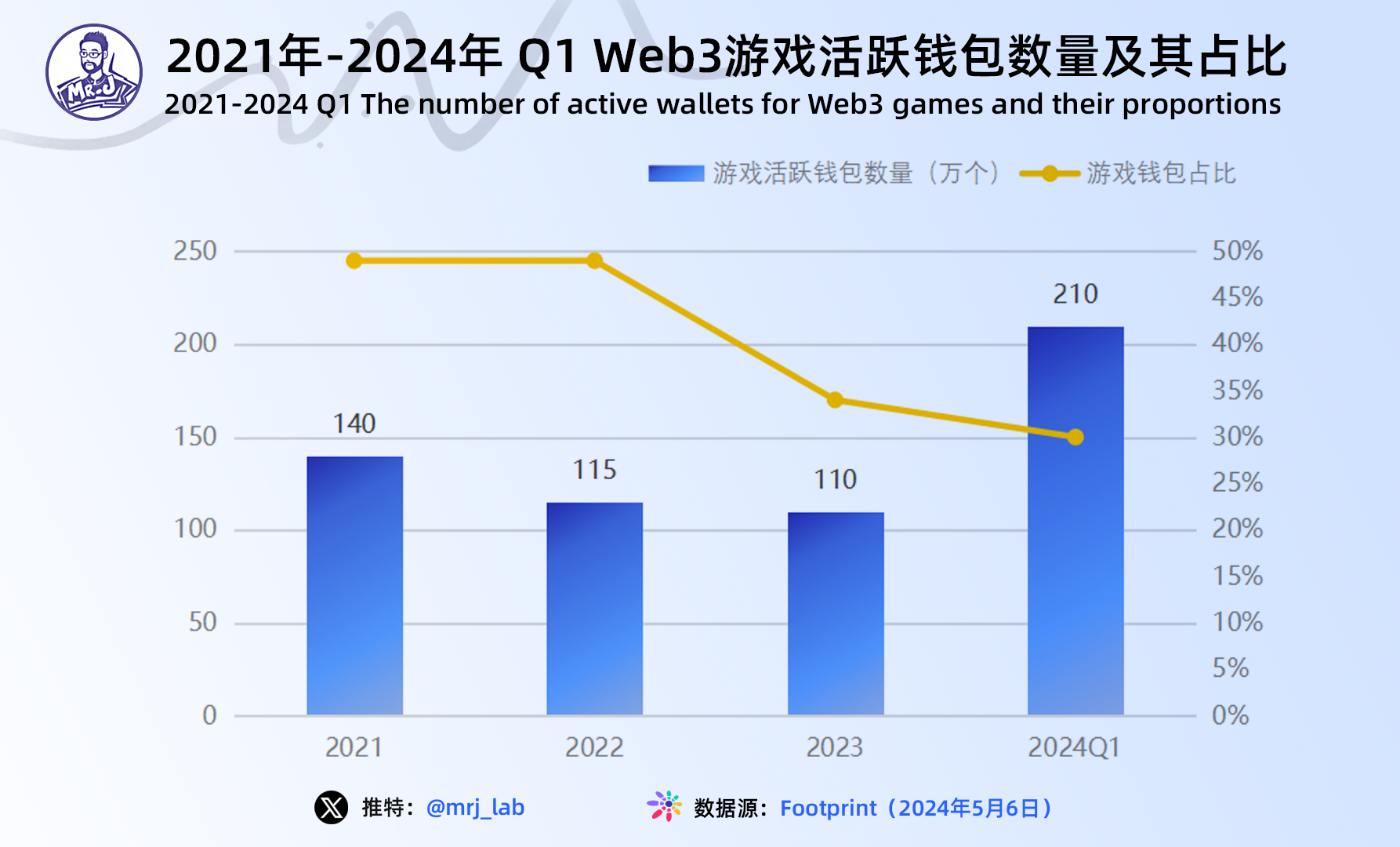
In 2023, there will be more than 3 billion game users worldwide, with a market size of nearly US$2,196.8 billion, of which Web3 game revenue will be US$5.2 billion (data source: Newzoo's Global Games Market Report 2023 | January 2024 Update). Although the number of users participating in Web3 games is still insignificant compared to traditional Web2 games, with continued growth and the arrival of the bull market in 2024, the Web3 game market has great growth potential.
2. Development process: from "rolling" Fi to "rolling" gameplay and playability
The focus of Web3 games has shifted from the early days of focusing on "Fi" and "material rewards" to more references to "gameability" and "playability" today.
First, let’s clarify the concepts of gameplay and playability. Gameability refers to the process and experience of players interacting with the game system in the game, focusing on the core gameplay of the game and the player’s participation, fun and long-term appeal in the game; playability focuses on evaluating the game’s ease of play and user-friendliness, focusing on the interface design, operation methods, teaching and guidance of the game.
In other words, compared with early Web3 games, today's Web3 games are more concerned with long-term appeal to players and user-friendliness. As for why this development trend has emerged? We can get a glimpse of this from the development history of Web3 games.
According to the development history, Web3 games can be divided into four categories:
Early Web3 games focusing on Fi, with Fi at the core, can be collectively referred to as GameFi;
X to Earn (X 2 E) games where users participate in daily game activities to receive material rewards;
AAA games that focus on high-quality graphics and playability to attract players;
A metaverse game that builds a virtual world.
GameFi combines the DeFi asset allocation principles with game elements. In the early days, it over-focused on financialization, attracting a large number of investors, but the game design and graphics lacked the depth and playability of the game, and could not attract real gamers. For example, in the early days of GameFi, Axie Infinity, players only focused on profit and not the gameplay itself, which often led to a much lower user retention rate than general games. According to Footprint Analytics data, Axie Infinity has now entered a period of stagnation, with only about 9,000 active users per day, and a user retention rate of only about 10% compared to the millions of active users at its peak.
Therefore, to develop a successful GameFi ecosystem, it is necessary to go beyond the basic principles of DeFi, develop a complex in-game economy, and prioritize user experience in game design. X2E games came into being. The X in X2E can be defined as any human behavior such as games or mobile, and earning income through these behaviors. Unlike early purely profit-oriented games, X2E attaches great importance to community culture and values, and usually uses meaningful real-life or creative behaviors as core game mechanisms. The most representative game is STEPN. STEPN gamifies real-life behaviors through sports and has a more user-friendly game mechanism: users are encouraged to participate in sports activities, complete specific goals, and submit completion certificates through the app to motivate users to maintain healthy activities.
3A games focus more on the playability and user base of the game on the basis of X2E, and the quality of the game has been significantly improved. With rich game background and excellent game mechanism, IIIuvium has inherent advantages in product quality and player experience.
Based on this, the core of the project's user retention strategy has gradually shifted from emphasizing gold-making income to improving the playability and intrinsic quality of the game.
3. Financing and Fundraising: Huge amounts of capital influx drives industry boom
Between 2021 and 2023, the Web3 game industry attracted a large amount of investment and financing. Among them, 2021 can be said to be the first year of Web3 game financing. This year, traditional venture capital institutions, cryptocurrency funds, angel investors, etc. actively participated in investing in the industry. In 2022, global Web3 game financing reached a historical high, with a financing amount of nearly 10 billion US dollars.
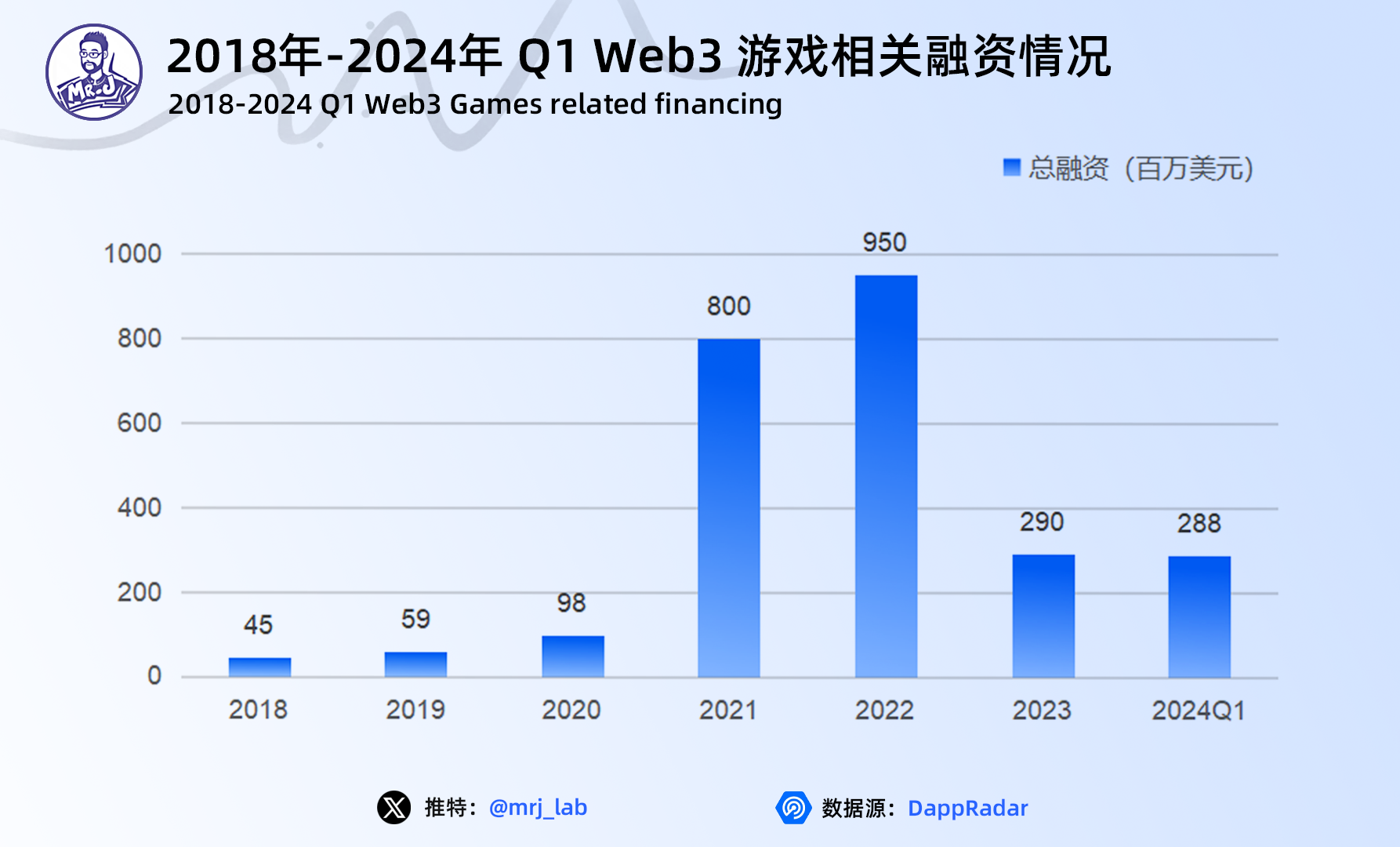
In addition, some Web3 game platforms have also begun to raise funds by issuing game platform tokens or conducting initial coin offerings (ICOs) to support the development and operation of the platform. This type of fundraising model has also attracted the attention of investors.
In the Web3 game track, there have been some eye-catching large-scale financing cases that have promoted the development of the industry. Taking into account the financing volume, financing results and media attention, J-Lab has compiled some financing cases of Web3 games in recent years to help understand the changes brought about by the influx of funds to the industry. For details, please refer to the table below.
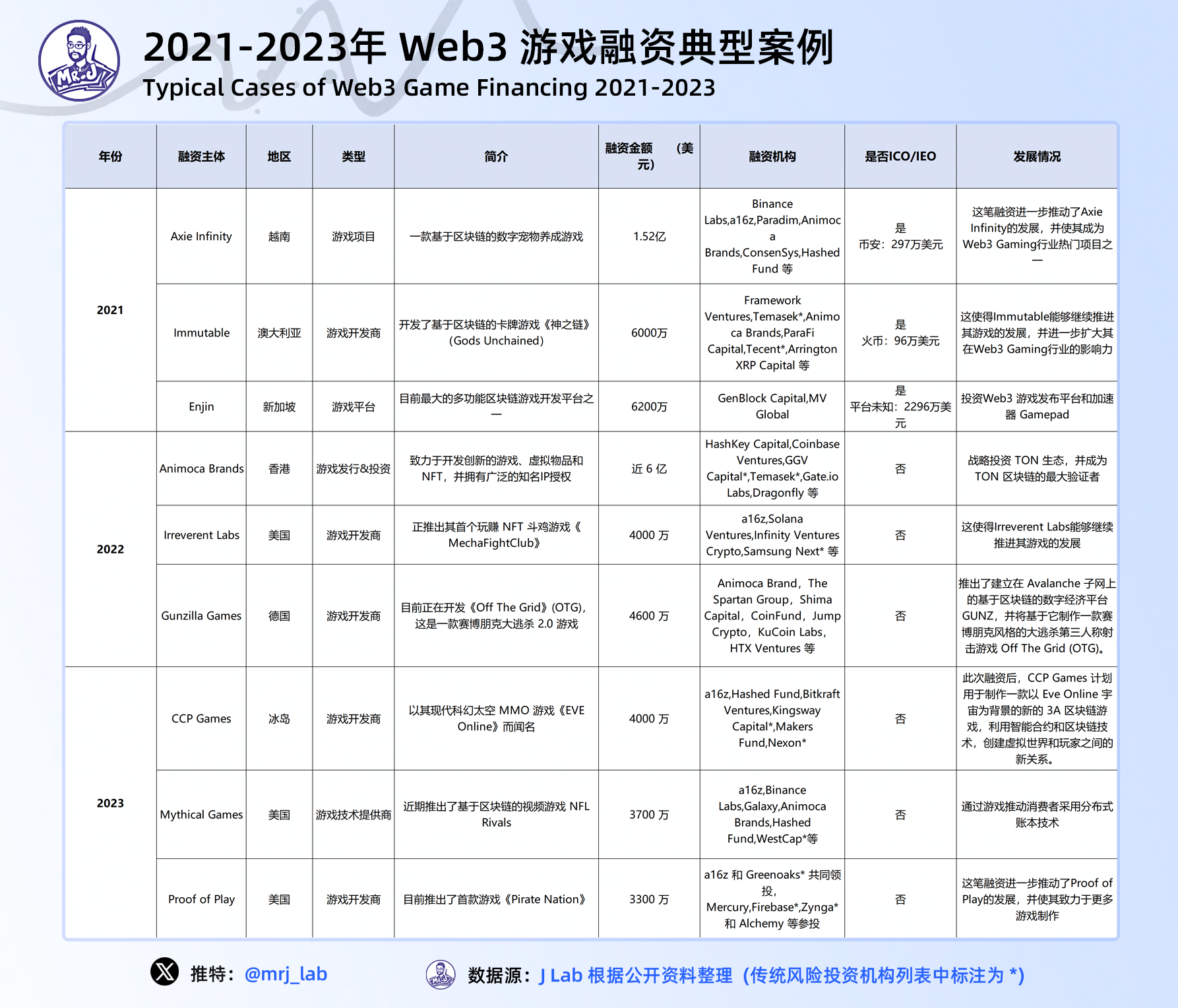
4. Challenges and risks: Sustainable development faces many challenges, such as excessive FI-ization of games and lack of user experience.
From the perspective of the game itself, although Web3 games have begun to focus on improving gameplay and playability, the high-quality game content on the market in 2021-2023 is still lackluster. The excessive fi-ization of games makes it difficult for the industry to cope with market fluctuations and the risks of speculative behavior. The lack of ease of use and friendly user interface also limits the participation and adoption of mass users. How to "break the circle" remains to be explored.
According to Game 7 Research data, more than half of Web3 games are currently developed by independent producers or small teams, while 3A or 2A level productions account for only 6%. Some projects focus too much on the technical and economic aspects, while ignoring the sophistication, innovation and richness and diversity of game design. This may lead to the risk of player loss and market saturation, limiting the long-term development of the industry. In addition, market competition may lead to the risk of over-investment and capital bubble. If there are too many similar projects in the market, and user demand and market capacity are limited, it may lead to the failure of some projects and capital loss.
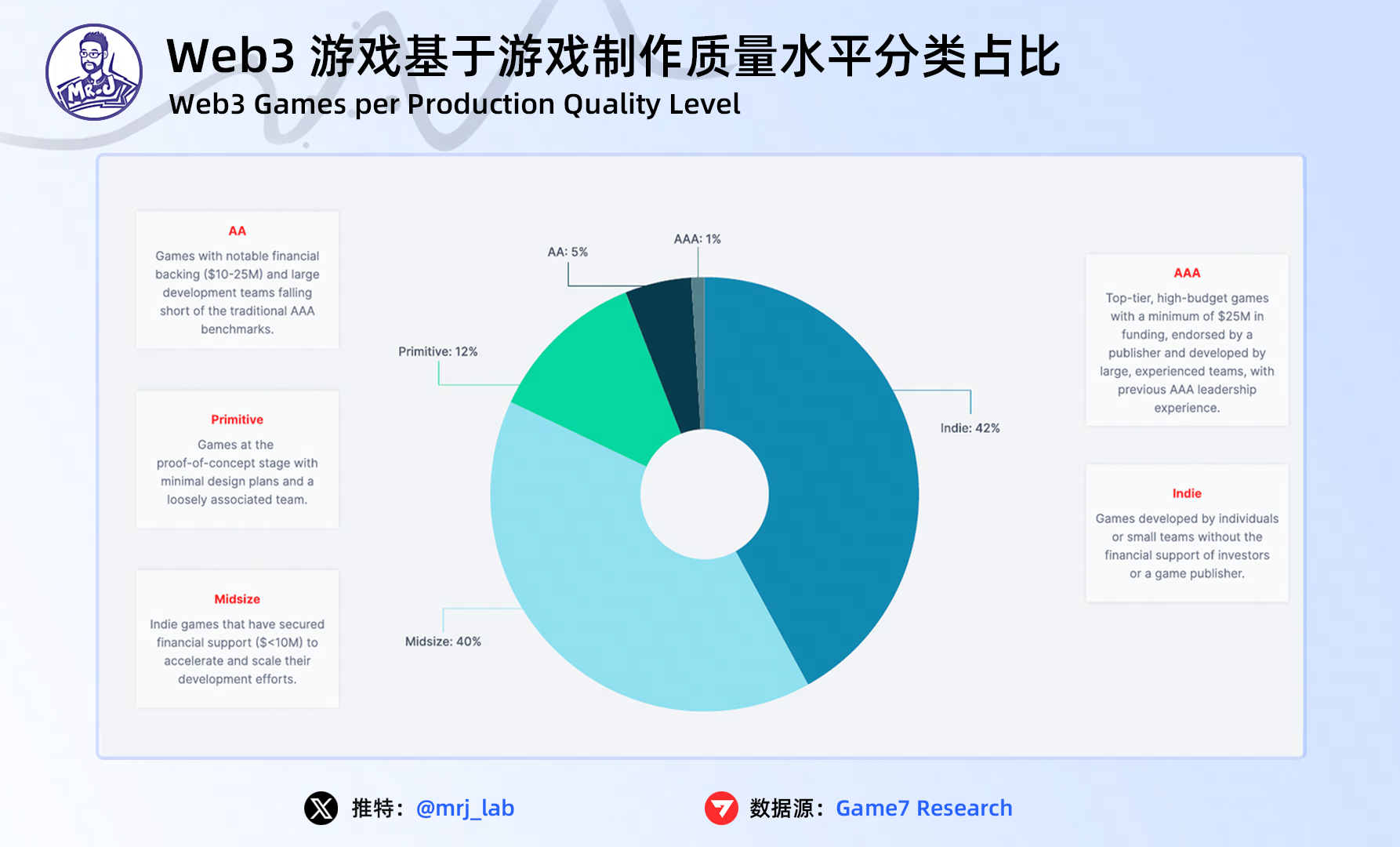
In addition, blockchain scalability, transaction speed, and fees also limit the smoothness and user experience of Web3 games. In order to compete with Web2 games, Web3 games urgently need to solve the user experience problem. For example, convenient and fast digital wallets and trading tools to smoothly manage and trade game assets. For the vast majority of Web2 users, participating in Web3 games may still have a certain learning cost. The lack of ease of use and friendly user interface may limit the participation of Web2 users, and it has also become a problem for games to break through the barriers of the circle.
2. Industry ecology: Panorama of Web3 game ecology
From the perspective of the industrial chain, the upstream of the Web3 gaming industry includes game content creation and R&D infrastructure, the midstream includes all To B service providers, the downstream covers all To C service providers, and the terminal is all players and paying users.
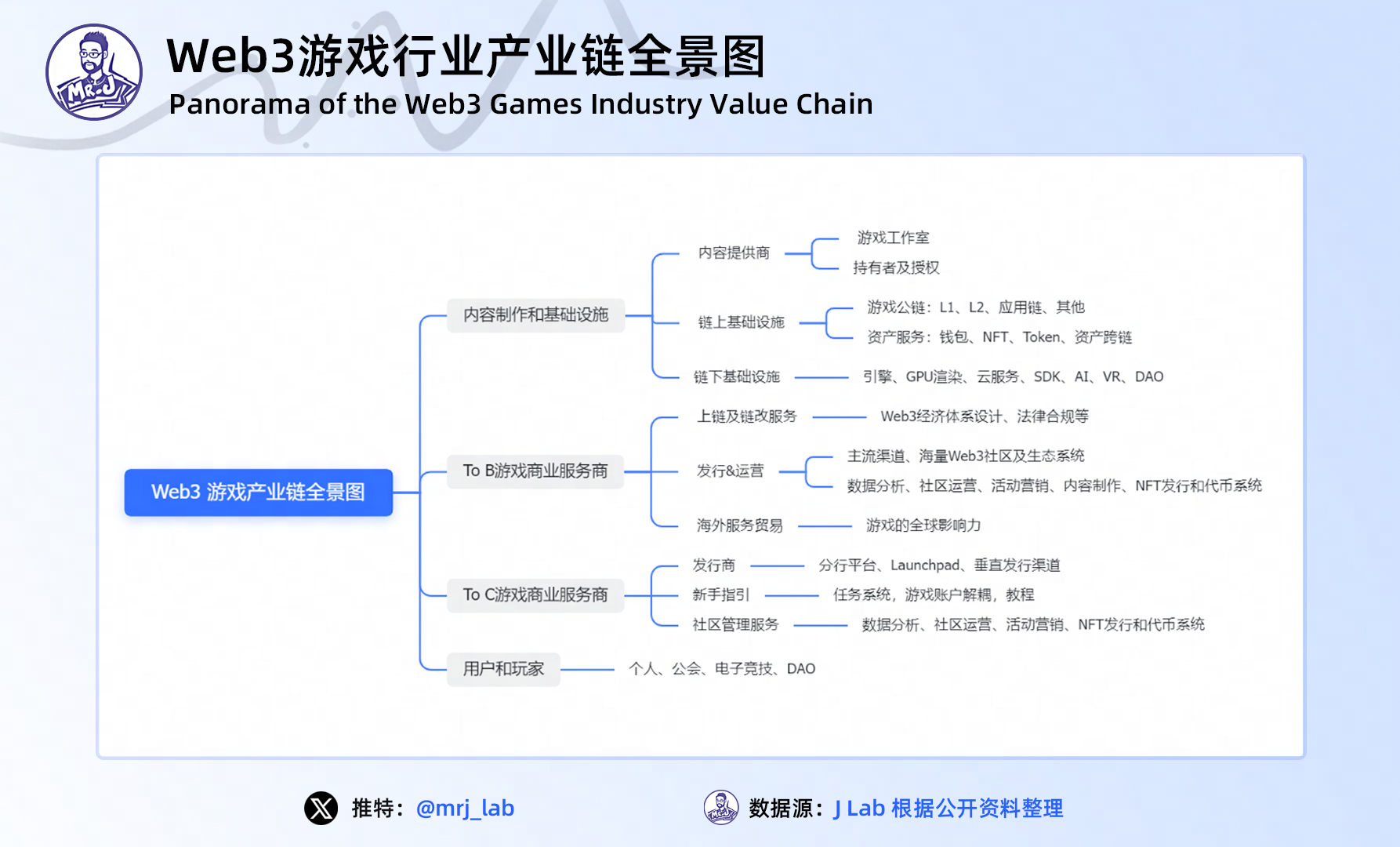
1. Upstream — Infrastructure: Game public chains have three-thirds of the market share, and BNB chain performs well
As the most important infrastructure, the game public chain is accelerating its layout and presenting a state of flourishing. Currently, there are three main types of Web3 game public chains: general-use chains (General-Use Networks), Appchain (Application-Specific Network Frameworks) and game-specific chains.
General public chains refer to public chains that can realize large-scale game applications and access. They can be divided into general L1 public chains and general L2/L3 public chains. General L1 public chains include Ethereum, EVM Sidechains, and Non-EVM Layer 1.
Appchain refers to a network designed and optimized for a specific game, application or ecosystem, such as Wax, Flow, Immutable X, Oasys and Hive, which are chains built specifically for games. This type of public chain not only has advantages in terms of expansion and speed, but also has customized optimizations for games, so it is more suitable for building games.
A game-specific chain refers to a public chain built specifically for a certain game, such as Axie Infinity's unique chain Ronin.
At the data level, the three types of game public chains have their own advantages in terms of scale, user participation, and transaction level. The number of projects on the chain can reflect the attractiveness and development vitality of the public chain. At present, the top three in terms of the total number of Web3 games on the chain are BNB Chain (28.9%), Ethereum (22.6%) and Polygon (14.8%), and the total number of the three is 66.3%, accounting for half of the Web3 games.
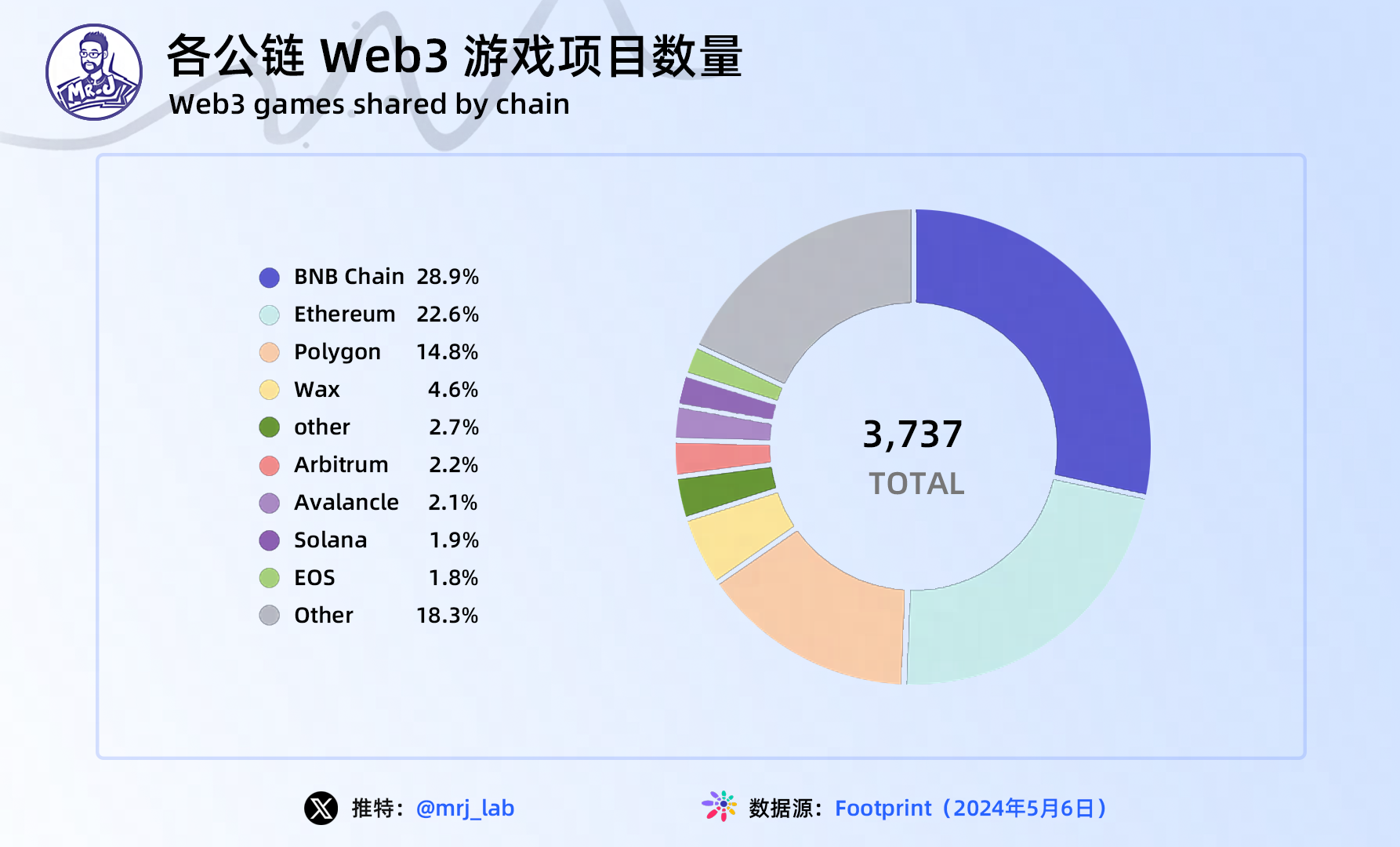
The number of active users on the chain is one of the important indicators of user engagement. Generally speaking, a higher number of active users indicates that the public chain has a broad user base and an active community. From the perspective of daily user data, the public chain's Web3 game users are mainly divided among Ronin (27.35%), Polygon (16.92%), Near (12.58%), and Klaytn (8.56%). From the data performance in the first quarter of this year, Ronin and Polygon have long occupied the top two positions in Web3 game daily active users.
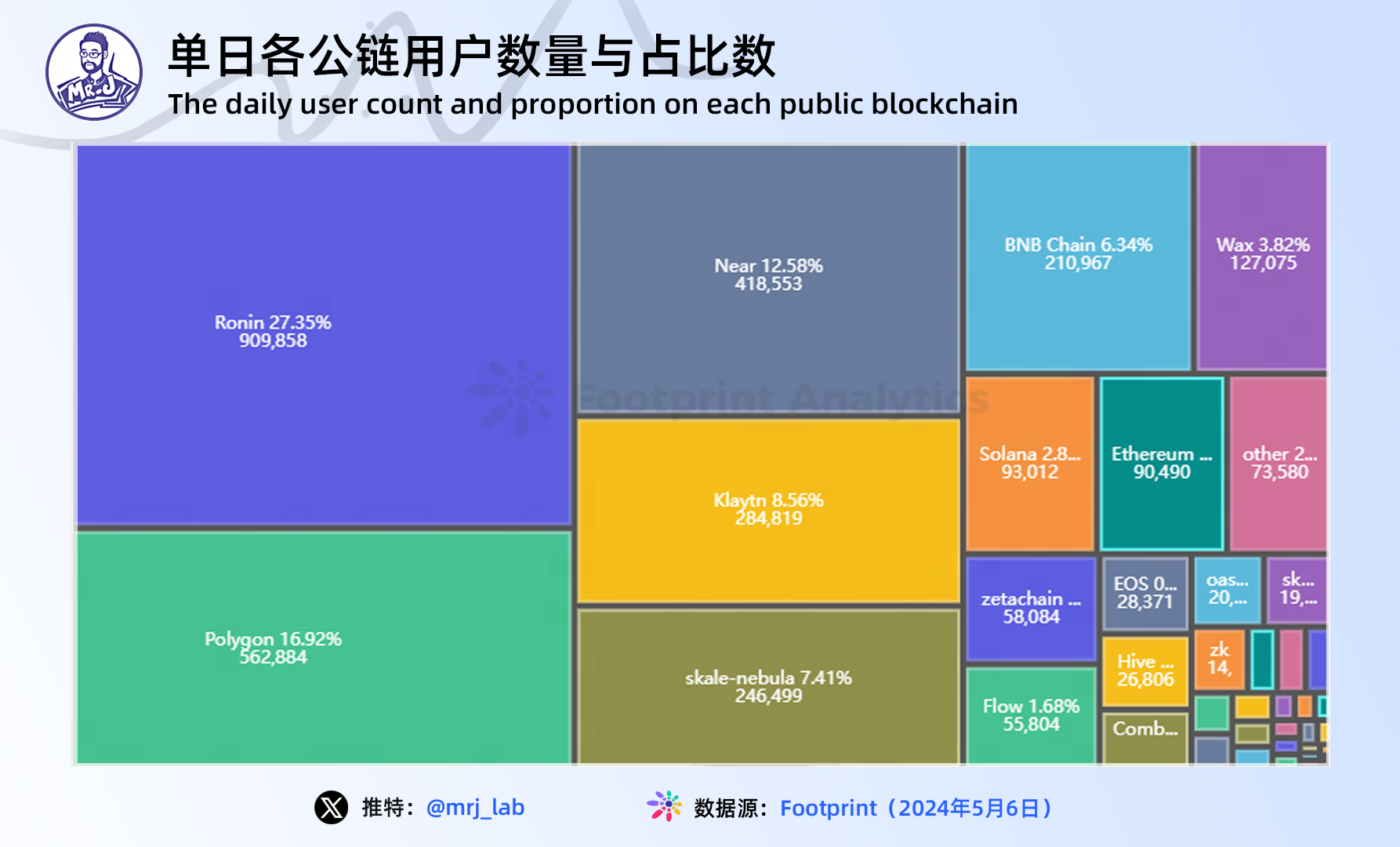
The transaction volume can indicate the liquidity and trading activity of assets. A higher transaction volume indicates that a large amount of value transfer and trading activities occur in the public chain. From the perspective of the overall transaction volume of the industry in recent years, the transaction volume peaked in the third quarter of 2023, then fell back and was lower than the average level in 2022. Although the transaction volume of the Web3 game market has dropped significantly compared to 2022, the number of transactions has not dropped significantly.
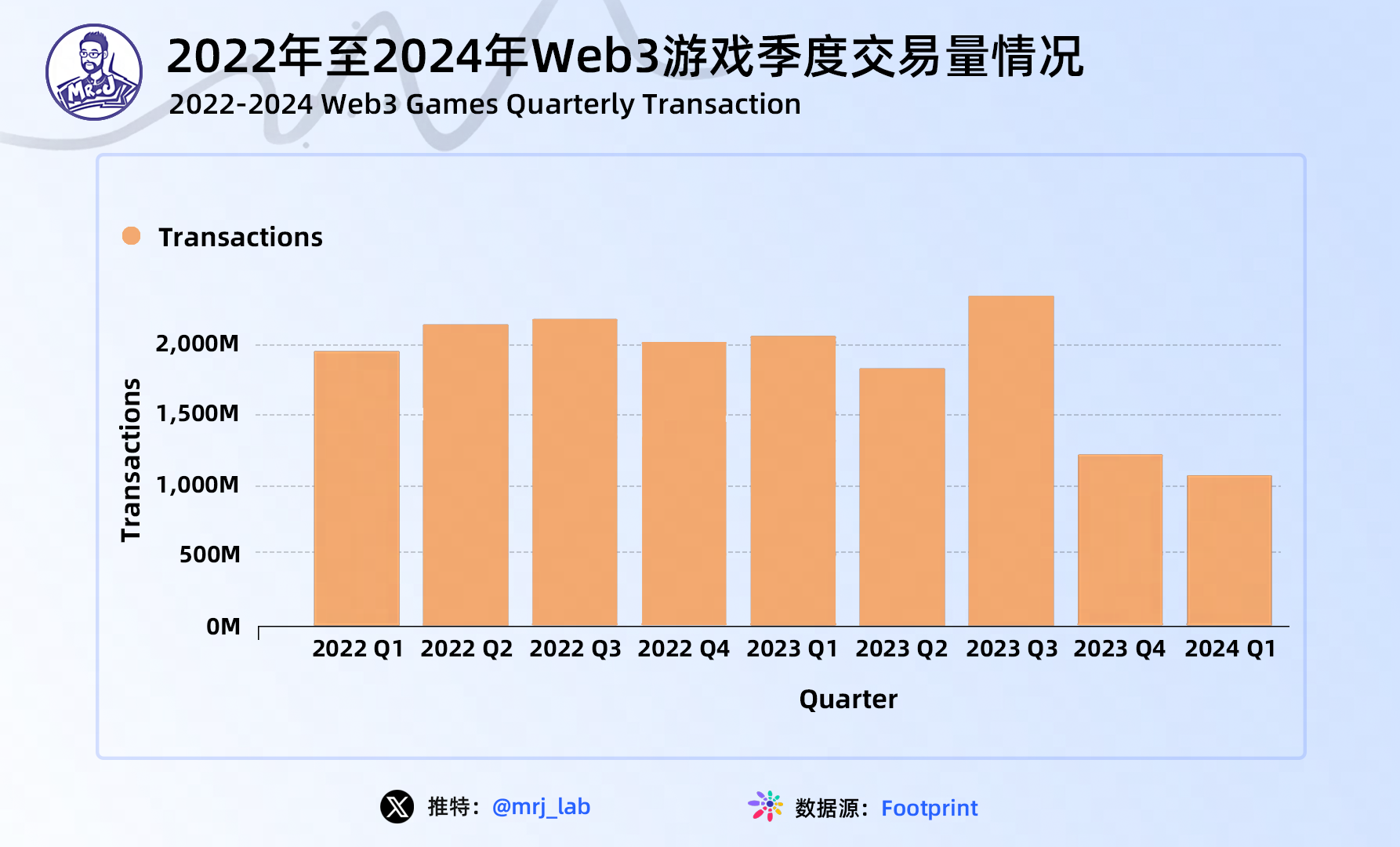
In terms of transaction volume, the four chains with the best transaction volume in the track are Wax (76%), Hive (8.2%), Sui (2.8%), and BNB Chain (2.3%). As a public chain built specifically for NFT and games, Wax leads with an absolute advantage, far exceeding the second, third, and fourth places.
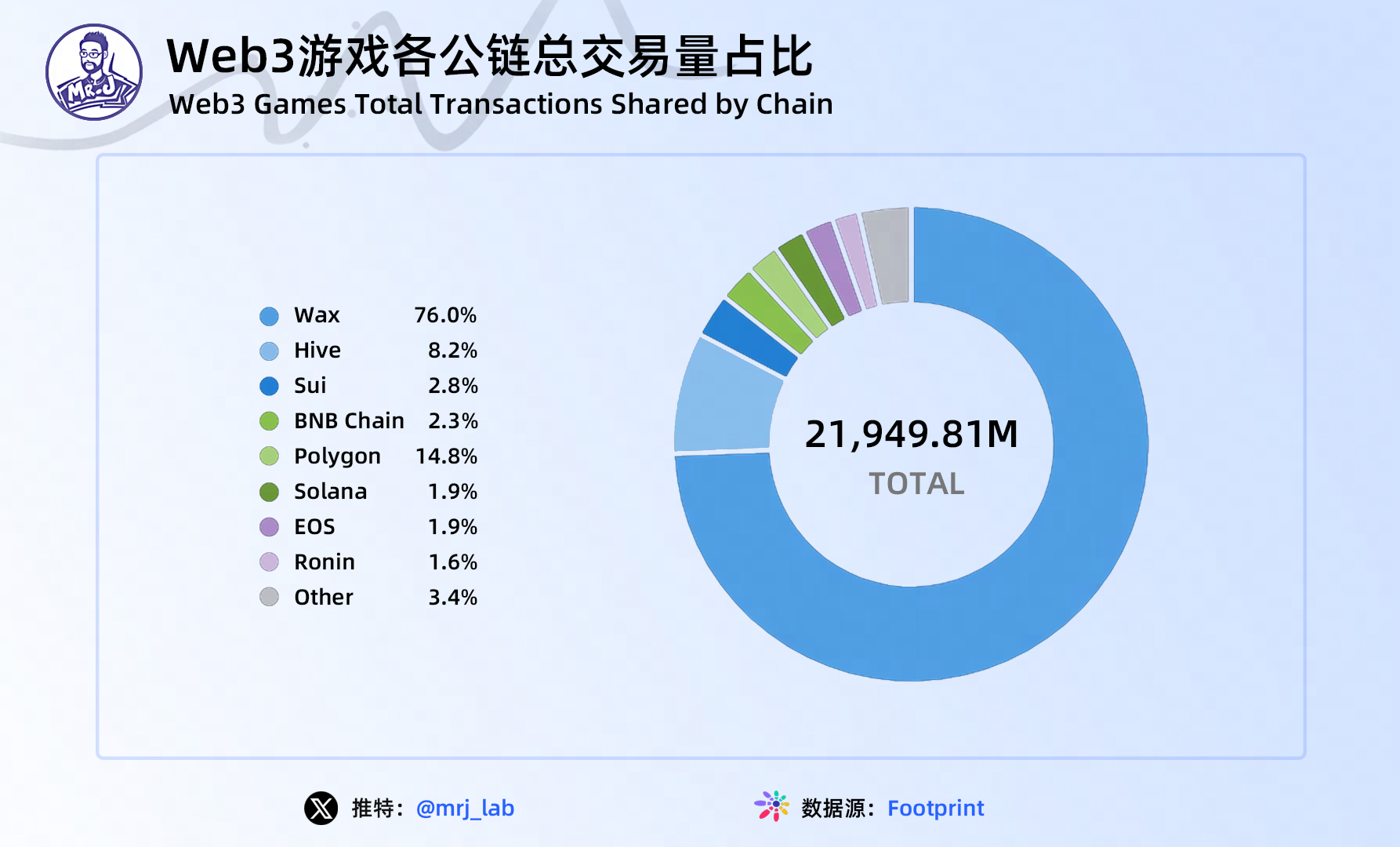
In general, the game public chain presents a situation of three-way distribution. BNB Chain and Avalanche, which adopt the EVM Sidechains model, Polygon, which combines sidechains and Layer 2, and Appchain — Wax and Hive all have outstanding data performance.
BNB Chain and Polygon have attracted a large number of game developers to develop and deploy games due to their good performance, low gas fees and support for EVM. In particular, BNB Chain, relying on the good ecology and project incubation plan of Binance Exchange, ranks among the top in terms of total number of games, number of active users and transaction volume.
Therefore, the public gaming chain that can be widely adopted in the future must have three elements: first, it must have high TPS and be compatible with EVM; second, it must meet the special needs of the game; and third, it must have good ecological construction capabilities.
2. Midstream — Game Distribution: More platforms seize the distribution of Web3 games
Web3 games are developing rapidly, and various accompanying problems have also arisen. In order to capture market trends and avoid risks, users need to use market analysis tools, community forums, and project evaluation platforms to better discover and analyze potential good projects; project owners need to achieve more accurate user acquisition, more touching and user-trusted marketing and maintenance, and how to improve cross-chain operability.
In order to solve this series of problems, more and more platforms have begun to target Web3 game aggregation and distribution, aiming to bypass traditional Web2 centralized distribution channels (Apple, Google Play, etc.) and build a mutually beneficial bridge between game parties and users.
More and more platforms are vying for dominance in Web3 game distribution with the goal of becoming the “Steam of Web3”. Compared to traditional Web2 games, Web3 game distribution platforms aim to give users more power through decentralization, thereby promoting a more player-centric and community-driven gaming ecosystem with a greater focus on user engagement.
For example, Potral, a cross-chain gaming platform that was just launched at the end of February this year, overcomes cross-chain and payment problems through network integration, LayerZero and other technologies, connects games and players on different blockchain networks, and allows players to play freely on one platform.
For another example, DeGame has set the goal of becoming a search portal for Web3 games. It has included more than 4,000 game projects, more than 1,000 chains and tokens, covering almost all major projects and tracks in the Web3 game market. Users can access or participate in these projects by searching or clicking.
In addition, in January 2023, Steam issued a statement banning Web3 games. The withdrawal of the monopoly giant provided more game platforms with an opportunity to compete for the dominant position in game distribution. This has led many game platforms to rush for the dominant position in game distribution. As shown in the attached table, at present, various Web3 game distribution platforms bring together game NFT markets, self-developed games, provide APIs or SDKs to developers, and access to DID, task-based marketing activities, access to guilds, dashboards and other functions have become standard features of the platform. At the same time, game development platforms and information aggregation platforms have also gathered a large amount of investment and financing, and the amount of financing for a single project is relatively large.
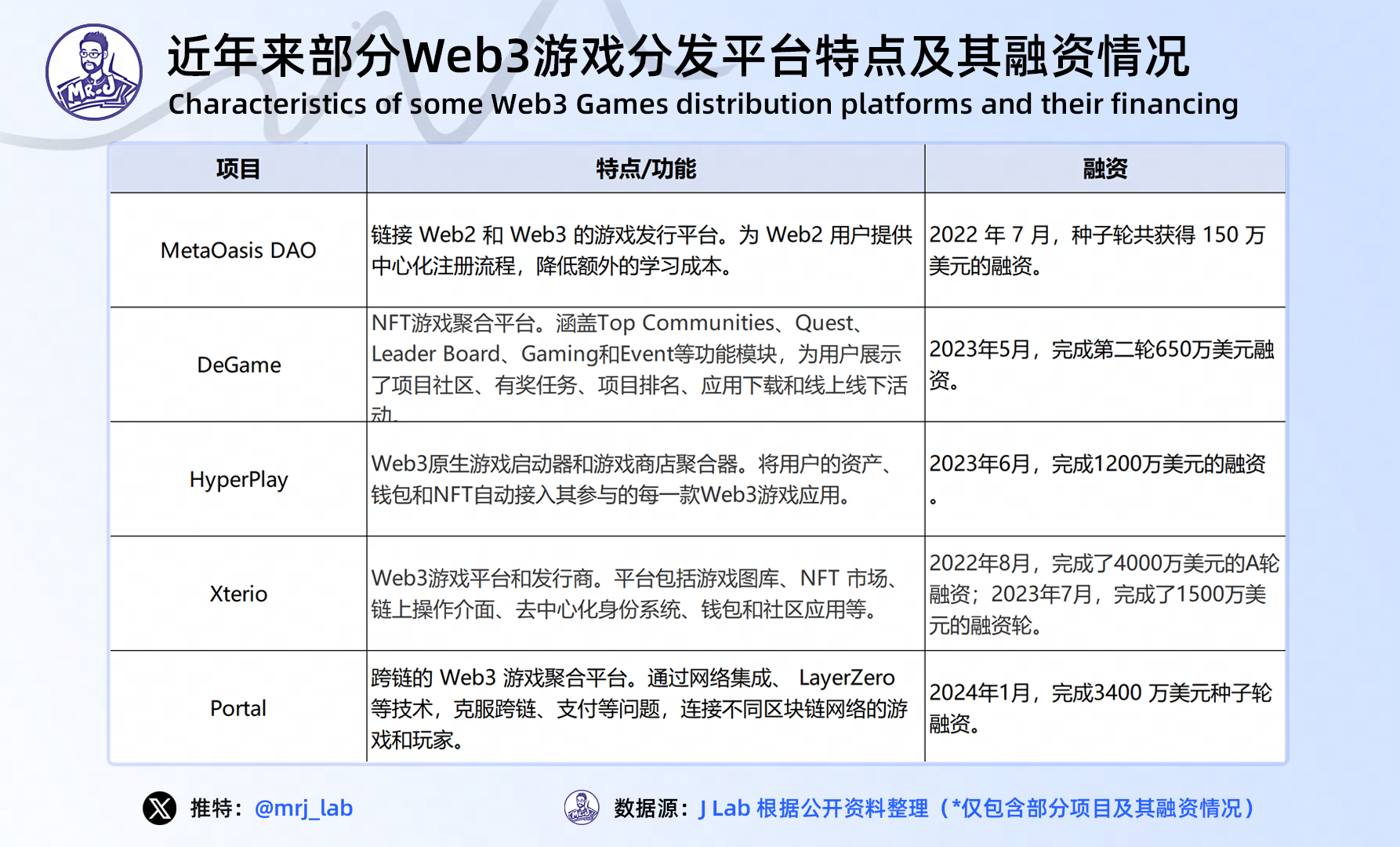
3. Downstream — Game community: Active communities promote user interaction, decision-making feedback, and economic incentives
Unlike Web2 games, the community plays a vital role in the Web3 game ecosystem. In Web2 games, large communities sometimes strongly oppose certain updates or policy changes, but in most cases, game studios rarely respond to them. In Web3, mechanisms such as community governance voting in games enable users to directly influence the development of projects. For example:
The developer wants to change the reward distribution formula for in-game battles and submits it for a vote — whether to implement it is decided by a certain percentage of players voting; (A real-life example from the Cards Ahoy! community vote)
Users in the Discord or Telegram community provide feedback and vote on certain suggestions.
The communities referred to here mostly appear in the form of DAO (Decentralized Autonomous Organization). Take Yield Guild Games (YGG) as an example. Its initial purpose was to create a game revenue earning community based on blockchain technology, so that more people can earn income through games, while also promoting the development of decentralization and digital assets. Unlike other game platforms, it uses blockchain technology to track game transaction data, making all transaction data transparent. YGG supports NFT assets and connects the investor community of blockchain players around the world, and is committed to providing players with opportunities to earn income through games in multiple blockchain games.
Currently, Yield Guild Games has launched multiple revenue earning programs, such as Axie Infinity, The Sandbox, League of Kindoms and other games, and manages and operates them through DAO. Organization members can participate in the organization's decision-making and development by contributing funds, game play, community building, etc., and can also share various revenue opportunities planned by the organization.
For Web3 games, community means an ecosystem of interaction and cooperation between players and project owners. This economic ecosystem encourages players to participate and contribute, increasing the sustainability and attractiveness of the game.
3. Industry trends: Review of new changes in the industry in 2024
Since the second half of last year, the Web3 gaming industry has shown signs of activity again: the industry has frequently received financing and attracted giants from the Web2 gaming industry to enter the market. At the same time, many games announced plans to conduct public testing in 2024. This series of dynamics has aroused the market's high interest in Web3 games, creating a prosperous scene. Compared with the previous cycle, the Web3 gaming industry in 2024 presents the following characteristics:
1. Feature 1: The playability and playability of Web3 games have been improved, and “earning gold” is no longer the only purpose
Today, Web3 games have gone through the hot stage of Play To Earn (P2E). Low playability and poor gameplay are considered to be one of the main obstacles to the development of Web3 games at this stage.
At this stage, Web3 games are moving towards high-quality graphics, rich content, and excellent player experience, and are even moving towards 3A production, tending to attract more Web2 players by improving the playability of the game. For example, BigTime, Illuvium, BLOCKLORDS, Shrapnel, etc. all use the slogan of AAA-level Web3 games.
The driving force behind the improvement of Web3 games mainly comes from two aspects. One is the unsustainability of excessive attention to Fi; the other is the pressure of competition from peers to break out of the Web2 circle.
The unsustainability of over-focusing on Fi. Early Web3 games paid too much attention to Fi, and it seems more appropriate to call it GameFi. However, the excessive focus on financial attributes did not attract more users to Web3 games. When the bull market dividend was no longer there and players' earnings were not as expected, the excessive focus on Fi accelerated the departure of Web3 players. As a result, the GameFi track ushered in an unprecedented cold winter in 2022, and its market value shrank rapidly, down 50% from 2021.
Competition pressure from peers to break the circle of Web2. At present, Web3 game players can be broadly summarized as the overlapping users of Web3 native users and Web2 game players. If the project wants to attract more active players to participate, expanding the intersection of the two may be the best choice. However, the former basically comes to make money, and playability is not their priority factor; the sensory depth and breadth of the latter have been "trained" by the traditional Web2 game market, and they are more accustomed to Earn (time/money) to Play, focusing on sensory pleasure; it is difficult to complete the large-scale conversion of Web2 users by relying solely on strong interest incentives. Only by starting from the essence of the game - improving playability and novelty, it is possible to break through barriers and achieve a true "breakthrough" from Web3 to Web2.
2. Feature 2: The types of Web3 games are becoming more diverse, with RPG, action, strategy and casual games being the most popular among developers
Compared with the previous cycle, the types of Web3 games will continue to improve. With the development of the industry, the types of games are becoming more and more diverse, including but not limited to the following types:
RPG (Role Playing) Games: RPG-type Web3 games are popular among developers. These games usually provide a deep role-playing experience, allowing players to play different roles and unfold adventures and stories in a virtual world.
Action games: Action Web3 games emphasize the player's operation and reaction ability. These games usually contain fast-paced battles and intense action scenes, and players need to use operational skills to complete tasks and challenges.
Strategy games: Strategy Web3 games focus on players’ strategies and decision-making abilities. Players need to develop strategies, manage resources, build bases or empires, and interact and compete with other players.
Casual games: Casual Web3 games are suitable for relaxation and entertainment. These games usually have simple and easy-to-understand gameplay and a relaxing and enjoyable gaming experience, which are suitable for fragmented time periods and a large number of players.
In addition to the above types, the types of Web3 games are constantly expanding and innovating, such as card games, racing games, puzzle games, etc. Compared with traditional Web2 games, the characteristics of Web3 games are that they are based on blockchain technology and encrypted assets, which makes the virtual assets in the game have real ownership and tradability, bringing players a new gaming experience and economic incentive mechanism.
The diversity and innovation of Web3 games are still evolving. With the advancement of technology and changes in user needs, more novel game types and gameplay may emerge.
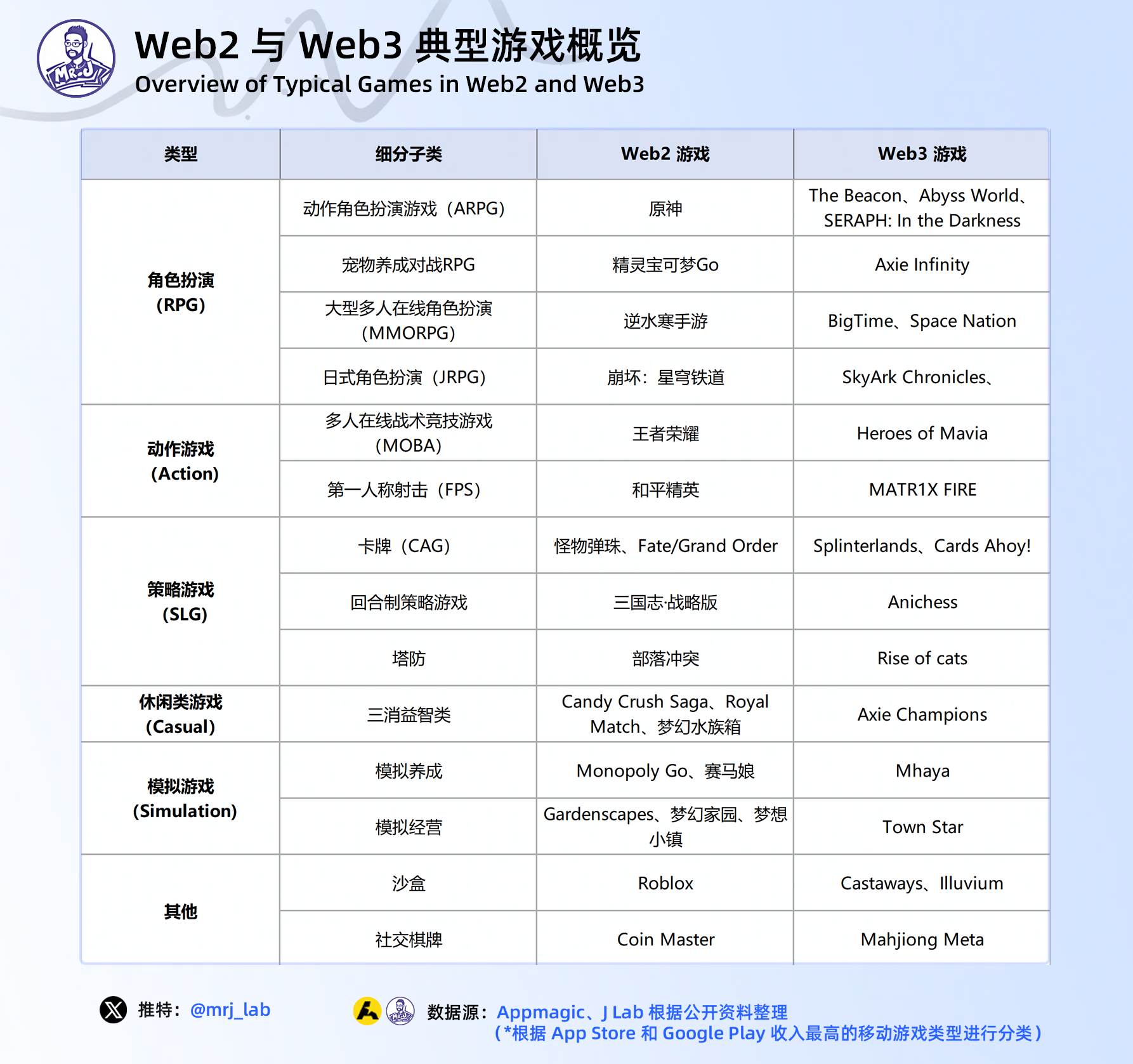
3. Feature 3: Web3 game projects are accelerating their evolution towards platformization and ecosystemization
Web3 games are evolving towards platformization and ecology to extend their life cycle and strengthen their connection and integration with other tracks. On the one hand, judging from past market performance, each Web3 game has a life cycle, and the length of the cycle is not only affected by the game itself, but also related to the overall trend of the Web3 market. Compared with a single game project, the game platform and ecology have stronger risk resistance, a longer life cycle, and greater trial and error space and development potential.
On the other hand, the platform is the best way to gather resources and open up the internal and external circulation of the game. The Web3 game information aggregation platform is an important tool for players to access the game, promoting the benign match between the game ecology and the players. For example, in aggregation information platforms such as IGN (Imagine Games Network), players can find introductions and reviews of most games and form judgments about the games. The multi-functional chain game aggregation platform can provide project parties with one-stop services such as game development, smart contract development, NFT casting and trading platform construction. For example, LootRush provides a quick start platform for Web3 games and provides non-fungible tokens (NFT) leasing to reduce the cost of game players and earn profits for NFT owners. Similar is Gala Games, which allows developers to design blockchain games while allowing players to own and transfer loot NFTs obtained in the game, and buy, sell and trade through peer-to-peer markets.
This trend can also be seen from the investment and financing situation. From the second half of 2023 to the completion date, 56% of the financing went to game platforms or game studios (companies), and investment in single games was relatively cautious. In the early stage, more than half of the investment and financing mainly went to game projects (53%).
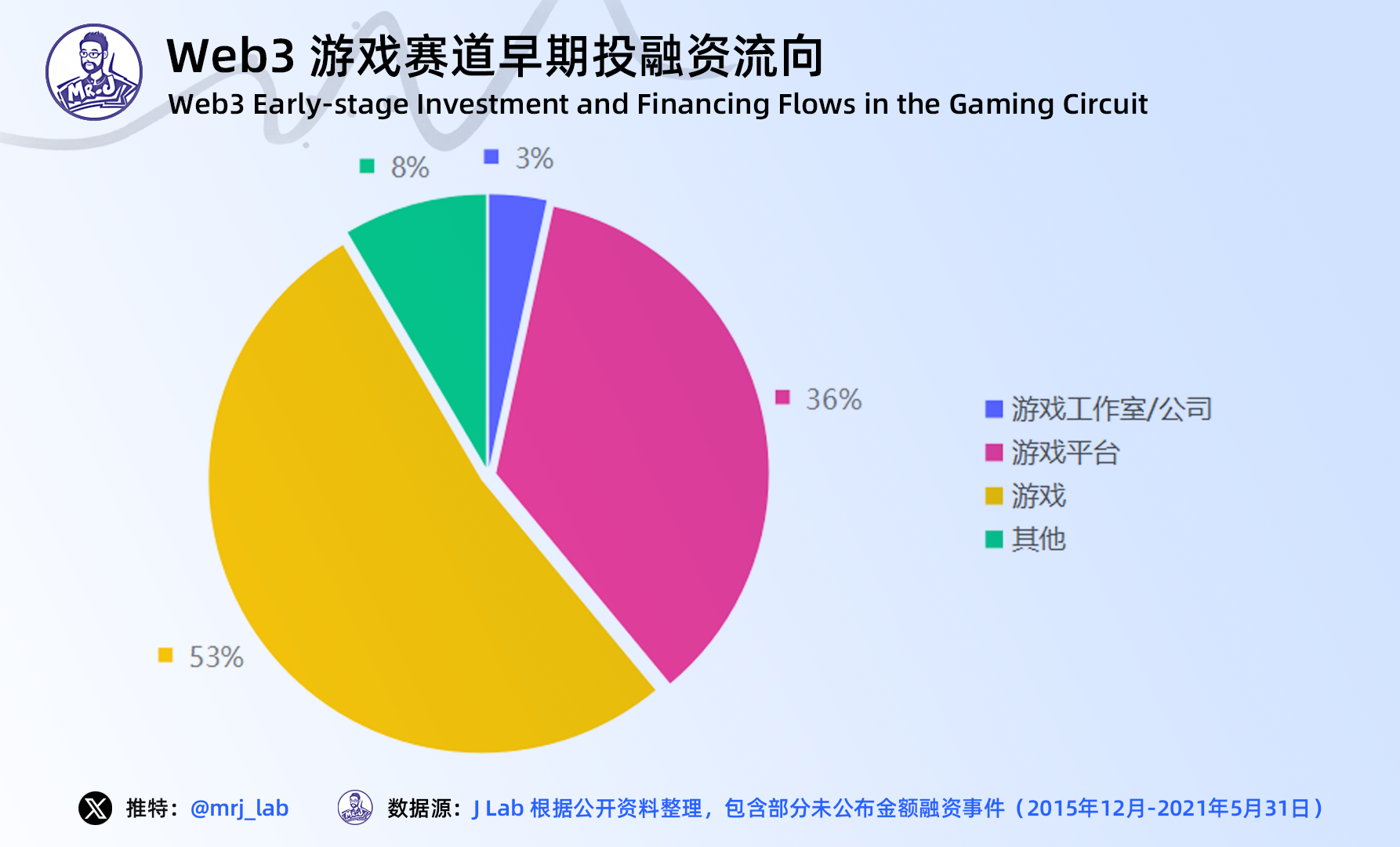
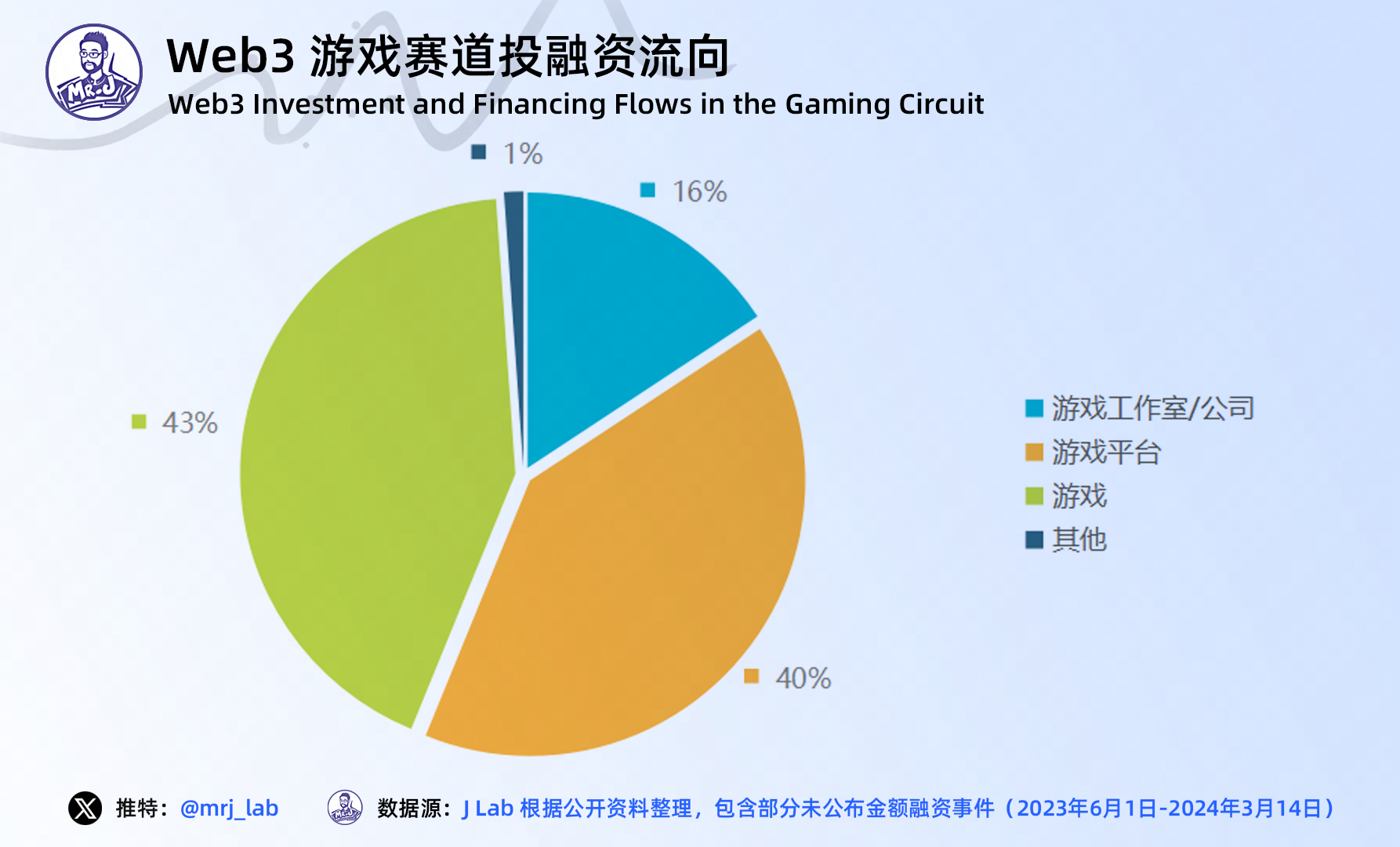
4. Feature 4: The community ecology of Web3 games may subvert the profit distribution model of the traditional game industry
The profit distribution model of the traditional Web2 game industry is relatively concentrated, and the right to speak is concentrated in the hands of a few leading companies. Web3 games, on the other hand, bring together multiple roles such as players, beneficiaries, and investors, and introduce token economics and complex economic systems. This not only reshapes the game's profit model and interaction methods, but also the game's economic ecology is centered on decentralization and community interaction.
Taking mainland China as an example, in the early development stage of Web2 games, R&D, distribution and channels were three relatively scattered and independent business systems. However, with the development and integration of the industry, in order to improve efficiency and control costs, the leading companies in the R&D, distribution and channel systems tend to expand their business territories upstream and downstream, and R&D and operation integration has become the mainstream direction of development for the leading Web2 game companies. This also means that the leading companies will monopolize market resources and distribution channels, players' choices will be limited, and the right to speak is concentrated in the hands of a few leading companies.
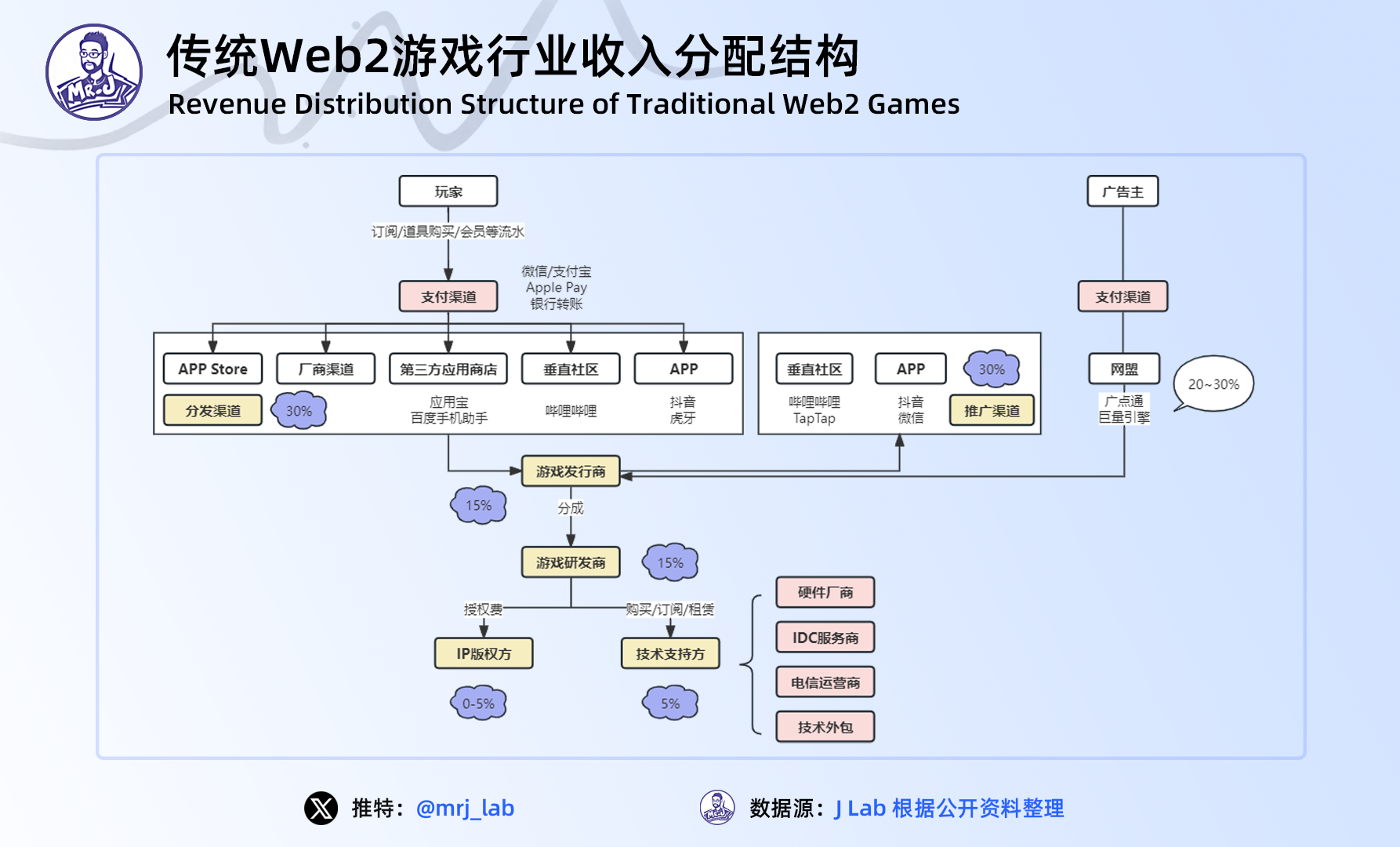
In contrast, the revenue distribution model of Web3 games is more decentralized. Players, publishers, and developers jointly create and distribute revenue. The decentralized model brings a fairer and more transparent profit distribution mechanism to players and developers, while also strengthening the importance of community participation and decision-making.
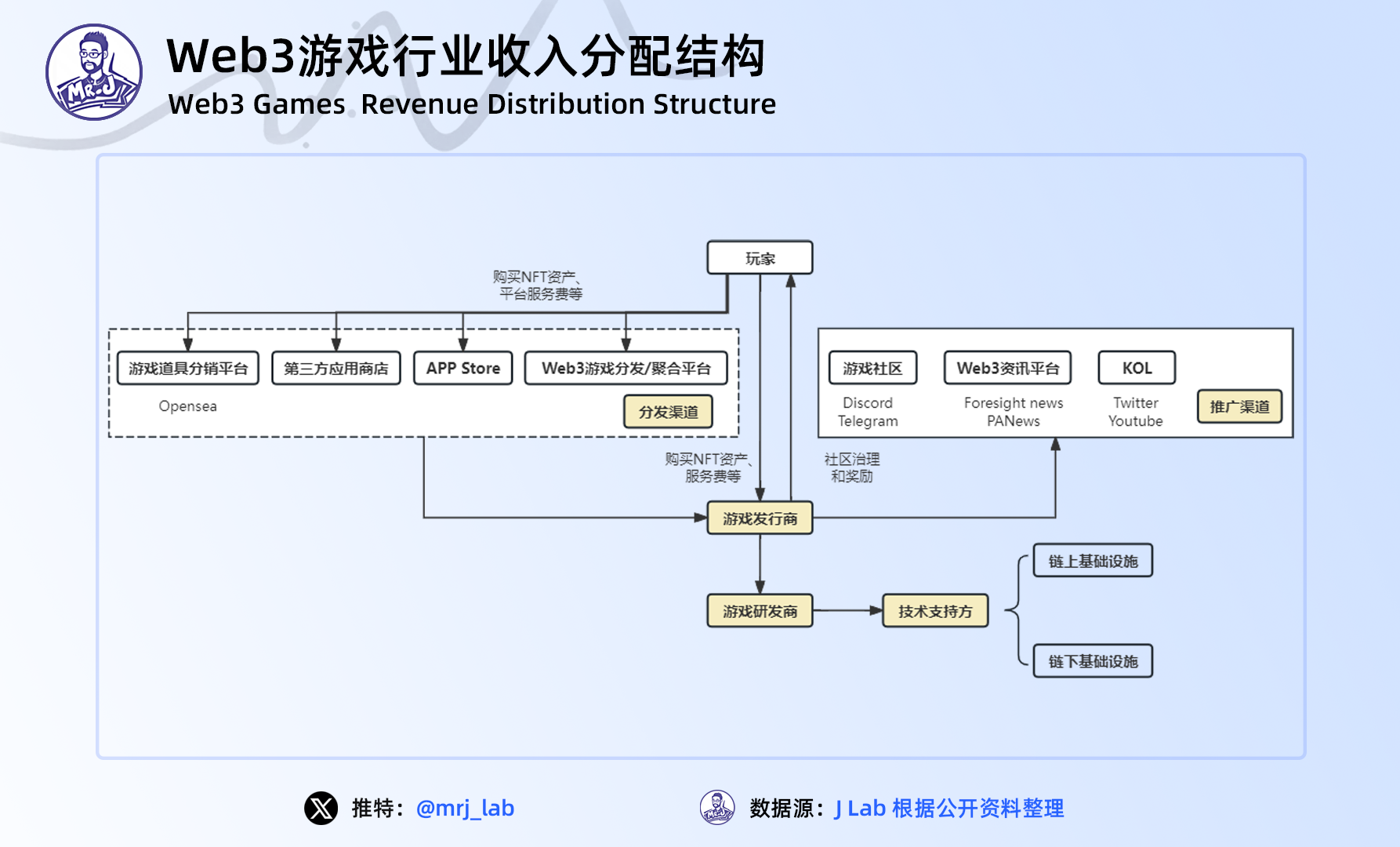
In addition to a sustainable game economy system, the role of the community in Web3 games is becoming increasingly important. A strong community is a key competitive advantage for Web3 games. The following are the top Web3 game communities that have grown in recent years and are still expanding in size.
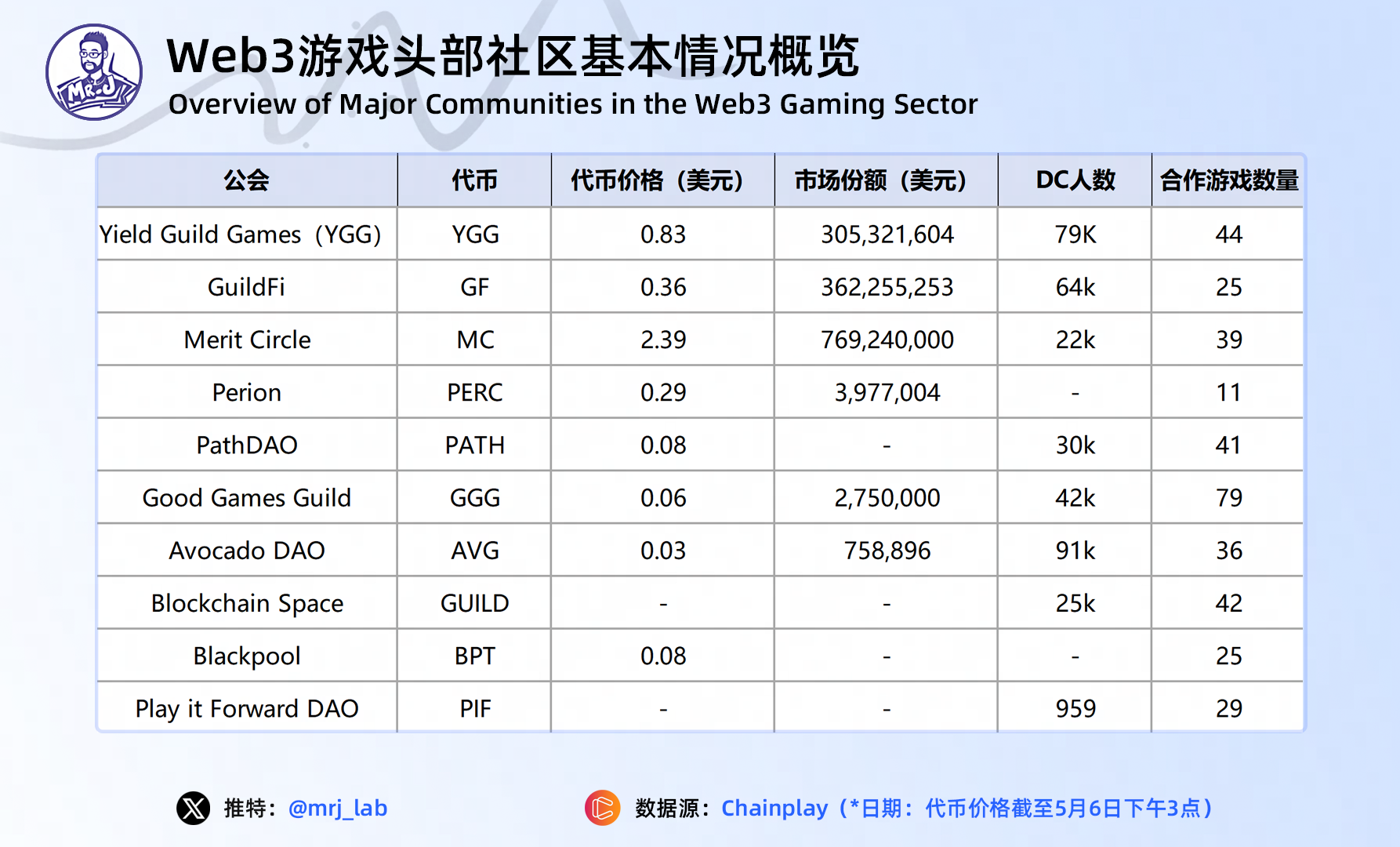
Over time, communities can become powerful entities that can achieve tangible results through collective action. Communities encourage collaboration and sharing among players. Players can co-create content, participate in game governance decisions, and exchange game strategies and experiences. Community members can support each other, communicate and share skills, thereby promoting the development and common progress of the game. Community members' feedback and suggestions on the game are also crucial to the improvement of the game. Game developers can use this to understand the needs and preferences of players, and timely adjust and improve the game's functions, balance and user experience, thereby providing better game products.
4. Talent Supply: Productivity and Production Relations in the Web3 Gaming Era
Economist Carlota Perez once systematically expounded on the "technological-economic paradigm" that drives social development. In her view, human history has experienced five technological revolutions, each of which has brought about new technologies, new key production factors, new infrastructure and the development of emerging industries. The process of technological revolution driving economic development is the "technological-economic" paradigm, and each great wave of historical development can be seen as a new paradigm that innovates the old paradigm.
1. Production release: innovative production engine under the innovation of Web3 gaming technology
The gaming industry has always been at the forefront of technological innovation. Modern gaming is a comprehensive art as well as a complex technology. After decades of development, an industry path has been formed from upstream underlying technology development, to midstream game content development and distribution, to downstream game distribution.
The Web3 technological revolution in the gaming industry brings about new technologies, new key production factors, new infrastructure, and the development of emerging industries.
The industrial ecology of traditional games generally includes four systems: upstream IP development, engine and other underlying technologies, midstream game developers and publishers, downstream C-end distributors and terminal users; the industrial ecology of Web3 games has a longer chain and more diverse subjects. In addition to game development, production and distribution, it also includes chain-up and chain modification, transactions and economic systems, etc., and its target audience includes not only C-end users but also B-end studios.
As an emerging industrial technology, the technological innovation of Web3 games is not only reshaping the industrial landscape of games, but also bringing about a rich industrial ecosystem of technology research and development, market transactions, and operational management in the upstream and downstream chains.
This innovative game science ecosystem is also creating a new productivity system, which can not only provide a large number of jobs for the regional game market, but also create a new Web3 game production relationship.
2. Paradigm evolution: production relations and institutional changes in Web3 games
The emergence of new productive forces has not only brought about changes in productivity and socio-economic levels, but also triggered profound changes in production relations and social systems.
Different from other industries in the Web3 ecosystem, Web3 games represent the new productivity of Web3, transforming the production factors and labor process of the original industry and building a new mode of production. At the same time, they also inherit the basic elements of the game industry. It can be said that Web3 games are the self-evolution of the game industry. In the evolution from the "old paradigm" to the "new paradigm", the original industry genes still exist.
Web3 games are decentralized, open, and practical, and are reshaping human communities, businesses, labor, and organizations. Based on blockchain technology and smart contracts, Web3 has decentralized organizational power. Anyone can create a DAO community around their own project and organize user participation. With the help of smart contracts, people voluntarily collaborate around a set of common values. At work, the completion of each task will be recorded on the blockchain and cannot be tampered with; project revenue is distributed through tokens, and the number of tokens is related to voting weight to achieve community governance.
Through on-chain records, token profit sharing and collective voting, a distributed cooperation and governance system has been formed, and DAO has basically achieved "self-sufficiency". This decentralized collaboration model means that Web3 work no longer requires a headquarters, there is no dedicated management, members can work with people around the world, and can choose to be anonymous or not. This is a parallel organization. The decentralized and distributed labor characteristics of Web3 provide people with job opportunities in the gig economy.
Web3 games are considered to be the most promising area for creating niche applications on the road to large-scale Web3 adoption, which can bring real ownership and economic incentives to players and bring new possibilities to the gaming industry. However, developing high-quality games is not a one-off process, but requires continuous investment, trial and error, and optimization, which places higher demands on the financial and technical strength of game developers.
Since 2023, Web2 game giants in various countries have accelerated the layout of Web3 business, and the development, marketing, and operation teams have increasingly merged with Web3 product and technology teams. In addition, many Web2 game studios that already have NFT-like elements in their built-in games will find this transition more natural when they enter Web3.
3. Talent direction: What kind of talents are needed for Web3 games?
In 2023, OKX and LinkedIn jointly released the 2022 Global Blockchain Talent Report - Web3.0 Direction. From a macro perspective, as of June 2022, the total number of blockchain talents increased by 76% year-on-year, among which India, Singapore and the United States had the highest growth rates, at 122%, 92% and 62% respectively.
The demand for talent is growing rapidly, increasing exponentially compared to the previous year. The demand is far greater than the supply, and there is a huge talent gap. It is worth mentioning that Canada's growth rate reached 560%. The growth rates of India, Singapore, the United States, and China were 145%, 180%, 82%, and 78%, respectively. In terms of talent supply, talent mobility is mainly internal mobility. According to reports, from 2021 to June 2022, talents mainly cross-flowed between blockchain companies such as Coinbase, Crypto.com, Gemeni, and Ripple. External inflows of talent are mainly distributed in the field of financial technology, such as Goldman Sachs, JPMorgan, HSBS, etc. In terms of the talent demand structure, a large number of basic jobs are often required in the early stages of industry development, such as R&D, development, and product construction. Finance, R&D, business development, information technology, and sales talents are still the most in-demand types.

Web3 games are an important part of the Web3 industry and an important catalyst for popularizing Web3. The underlying logic and business system of Web3 will bring changes to the traditional game industry. However, the talent system of Web3 games is not a simple superposition of games and Web3, but an organic integration of the two relationships.
As the Web3 game industry enters a deep water period, simple gold farming and financial games can no longer meet the needs of users. More exquisite art design, more attractive gameplay design, and more sustainable economic system are increasingly becoming the key to the success of a game. The future Web3 game studio must be composed of people who understand games and are embedded in the Web3 ecosystem.
R&D and development talents: Web3 games need technically capable R&D and development personnel, including blockchain developers, smart contract developers, and front-end and back-end developers. They should have solid programming and development skills and understand blockchain and encryption technology.
Game Designers: Web3 games need to have innovative and attractive game designs. Game designers should have a deep understanding of game mechanics and gameplay, and be able to integrate Web3 technology and economic systems into games to provide a more interesting and sustainable gaming experience.
Art Designer: Exquisite art design is essential to attract users and improve user experience. Web3 games need art designers with artistic and design skills who can create stunning game interfaces, characters, and scenes.
Economists and game economic designers: The economic system of Web3 games is one of the keys to their success. Economists and game economic designers should be able to design sustainable and attractive game economic models to ensure that the economic circulation and incentive mechanisms in the game can run smoothly.
Product Manager: Product managers play a vital role in the development of Web3 games. They need to understand market and user needs and translate them into specific product planning and functional design.
Blockchain experts: Since Web3 games are closely related to blockchain technology, talents with blockchain expertise and experience are very important in the Web3 gaming field. They should understand different blockchain platforms and protocols and be able to apply them to build game systems and features.
At the same time, more talent dividends will be released in the chain of Web3 game production, chain-uploading, and distribution, which also provides traditional Web2 game talents with diverse jobs and opportunities to enter Web3. However, these talents must identify with and understand the spirit of Web3, and be able to quickly learn Web3 technology and scenarios and combine them with gaming experience to transform into the ability to play Web3 games.
Of course, the current Web3 games are still in a very early stage, and no large-scale industrial cluster has been formed in any country or region in the world. However, the tight demand for talent has already emerged, and now is an opportunity to seize the opportunity.
Conclusion
As the early enthusiasm gradually subsided, VCs and project parties began to return to rational thinking, no longer chasing short-term explosive growth, but paying more attention to sustainable development, the rationality of economic models and long-term user retention.
This turn of events has brought new opportunities to Web3 games. Although no one knows when the “winter” of Web3 games will end, everyone knows that the bull market of Web3 games will be brilliant.
Will Web3 games have their “iPhone moment” in 2024? We’ll always be looking forward to it.
References
Research
Web3 Growth Hacker Series: How to Gain In-depth Insights into GameFi Players?
2023 Annual Survey of the Blockchain Game Industry: Acquiring new users is the biggest challenge, and the P2E model still has room for development
GameFi 2022 Annual List and 2023 Outlook Report
Web3 Game Industry Chain: Commercial Transformation of Games
Creator Economy in Web3 Games: From Games to Platforms, the Challenge of User-Generated Content
Sector rotation or fundamental improvement, how did GameFi become so popular this time?
Comprehensive thinking on blockchain games: Let’s talk about asset structure, asset issuance, etc.
The future of Gamefi's blockchain gaming economic model
GameFi Summer is coming? An article reviews the Web3 games and their progress that have received large amounts of financing in the bear market
A brief analysis of the current status of Web3 user data and "market growth logic"
Learn more about Immutable X: solutions, team, tokens, and gaming ecosystem
Messari: In-depth analysis of Arbitrum’s prosperous ecosystem
Top Video Game Companies Have Their Sights Set on Web3
Blockchain Game Report: Blockchain Games May Be Revived in 2023
GameFi's new changes: AI-driven Web3 games | Trendx Research Institute
When the Web3 narrative winter comes, are games the "fire" in the winter?
From the perspective of the traditional gaming industry, how should blockchain games develop?
Web3 Game Panorama: Interpretation of Various Players
Mapping the GameFi Ecosystem.
Unveiling the Future of GameFi: Trends and Outlook for 2024
2023 Public Chain Development Report
Value Decrypted: How to Dig for the Next Axie Infinity Through Major Web3 Game Platforms?
news
70% of top game companies are rushing to the Web3 market. Are AAA blockchain games just around the corner?
MetaMask's monthly active users have risen above 30 million, approaching the all-time high
Singapore’s Web3 progress is mixed under policy influence
A brief introduction to Hong Kong’s Web3.0 policies since the release of the “Declaration”
Disclaimer: All content on this site may involve project risks. It is for popular science and reference only and does not constitute any investment advice. Please treat it rationally, establish a correct investment concept, and improve risk prevention awareness. It is recommended to consider various relevant factors before interacting and holding, including but not limited to personal purchase purpose and risk tolerance.
Copyright Notice: The copyright of the quoted information belongs to the original media and the author. Without the consent of Uncle Jian J Club, other media, websites or individuals are not allowed to reprint this site's articles. Uncle Jian J Club reserves the right to pursue legal liability for the above-mentioned acts.



